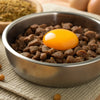What Raw Food Can I Feed My Dog? An In-Depth Guide for Pet Lovers
- Houndsy
Table of Contents
- Introduction
- Understanding Raw Diets for Dogs
- What Raw Food Can I Feed My Dog?
- Ensuring a Balanced Raw Diet
- Transitioning Your Dog to a Raw Food Diet
- Safety Considerations When Feeding Raw
- Conclusion
- FAQs
Introduction
Did you know that the dietary choices we make for our furry friends can significantly impact their health and wellbeing? In fact, a growing number of dog owners are opting for raw food diets, with some surveys indicating that up to 15% of pet owners are trying or have tried a raw feeding regime for their dogs. Choosing the right diet is crucial for our pets, as nutrition directly affects their vitality, coat health, and digestion. This raises the important question: What raw food can I feed my dog?
In this blog post, we'll dive deep into the world of raw feeding, exploring its benefits, various options, safety considerations, and how to effectively transition your dog to a raw food diet. By the end of this comprehensive guide, you will have a clear understanding of which raw foods are suitable for your dog, how to balance their diet, and what precautions to take when preparing and serving raw meals.
So, let’s reflect on your current pet feeding routine. Are you concerned about nutritional deficiencies in commercial kibble? Or maybe you're curious about the health benefits attributed to a raw food diet? Let's embark on this informative journey together, ensuring we provide our beloved dogs with the best possible nutrition.
Understanding Raw Diets for Dogs
The Basics of a Raw Dog Food Diet
A raw dog food diet typically consists of uncooked meat, bones, fruits, and vegetables, designed to mimic the natural diet of dogs' wild ancestors. The cornerstone of these diets is that they prioritize whole, unprocessed foods, which advocate for a diet that aligns closely with what dogs would have consumed in the wild.
At its core, a raw food diet for dogs can include various components:
- Muscle Meat: This forms the primary protein source, contributing to muscle maintenance and energy.
- Organ Meats: Rich in nutrients, organs such as liver and kidney provide essential vitamins and minerals that are critical for overall health.
- Raw Edible Bones: These not only supply important calcium but also help keep teeth clean.
- Fruits and Vegetables: While optional, incorporating dog-safe fruits and vegetables can enhance the nutrient profile of the diet.
- Supplements: Depending on the specific needs of the dog, additional supplements like fish oil or probiotics may be beneficial.
Benefits of Feeding Raw
Transitioning to a raw food diet can provide numerous benefits for our canine companions, including:
- Improved Coat Health: Many dog owners report shinier coats and healthier skin after switching to raw food, primarily due to the increased levels of Omega-3 fatty acids found in certain meats and fish.
- Better Digestion: A raw diet can lead to smaller, firmer stools, resulting from the high digestibility of raw ingredients.
- Enhanced Energy Levels: Raw-fed dogs often exhibit increased stamina and vitality, leading to an overall boost in behavior and playfulness.
- Weight Management: Because raw diets are free from grains and excessive fillers, they can help maintain a healthy weight for dogs prone to obesity.
Common Mishaps and Misconceptions
Despite the clear benefits, there are some common misconceptions associated with raw feeding. For instance, some pet parents worry about the risk of bacteria like Salmonella or E. coli in raw meat. These concerns are valid but can often be mitigated through proper handling and sourcing. Additionally, many believe that raw food diets lack essential nutrients, but with the right balance of ingredients, a raw food diet can be nutritionally complete.
Comparing Homemade Raw vs. Pre-Made Raw
When deciding whether to feed homemade raw meals or pre-made raw food, both options have their strengths and weaknesses.
Homemade Raw:
- Pros: You have complete control over the ingredients, allowing customization for your dog’s specific needs and preferences.
- Cons: Balancing the diet can be tricky, requiring extensive research. There's also a risk of nutritional deficiencies if not planned correctly.
Pre-Made Raw Food:
- Pros: Convenience! Pre-made raw meals are formulated by experts to ensure they meet all of your dog's nutritional needs, taking the guesswork out of meal preparation.
- Cons: There may be a perception of higher costs, though when considering time and effort saved, they may be more economical than homemade diets.
What Raw Food Can I Feed My Dog?
Now that we've covered the basics let’s explore various types of raw food that are safe and beneficial for dogs.
Safe Raw Meats
- Chicken: A popular protein choice, chicken is great for providing essential amino acids and is low in calories.
- Beef: Rich in protein and iron, beef is an excellent option but should be fed in moderation due to its higher fat content.
- Lamb: A great alternative protein source, especially for dogs with allergies to more common meats.
- Turkey: Similar to chicken in nutritional value, turkey can be a lean protein-rich choice.
- Fish: Salmon and mackerel are excellent for omega-3 fatty acids, which are beneficial for skin and coat health but should be given in moderation due to potential mercury exposure.
- Duck: Another protein source, duck is suitable for dogs that may have sensitivities to more traditional meats.
- Rabbit and Venison: These proteins offer novel options for pets with food allergies.
Organ Meats and Bones
- Liver: Extremely nutrient-dense, liver provides essential vitamins A and B, but should only be offered in moderation to avoid imposing too high of a concentration of vitamin A.
- Kidney and Heart: These organ meats are crucial for a balanced diet and provide additional minerals.
- Raw Bones: Only give raw bones, as cooked bones can splinter and cause internal damage. Raw bones can also assist with dental health.
Fruits and Vegetables
Incorporating certain fruits and vegetables can enhance your dog's diet by offering additional vitamins and fiber. Some dog-safe options include:
- Carrots: High in beta-carotene and low in calories, they make a great crunchy snack.
- Blueberries: Packed with antioxidants, blueberries can help support a healthy immune system.
- Pumpkin: Great for digestion, pumpkin can be a beneficial addition to your dog’s meals.
- Broccoli and Spinach: These leafy greens provide vitamins and minerals while aiding digestion.
Foods to Avoid
When considering a raw food diet for your dog, be aware of which foods are toxic or harmful. Avoid:
- Onions and Garlic: These can damage the red blood cells in dogs.
- Grapes and Raisins: Even small amounts can lead to kidney failure.
- Avocado: Contains persin, which can be toxic to dogs.
- Chocolate: Highly toxic, as it contains theobromine.
Ensuring a Balanced Raw Diet
When feeding a raw diet, balance is paramount. One commonly advocated structure for raw meals is the BARF diet (Biologically Appropriate Raw Food), which recommends:
- 70% Muscle Meat
- 10% Raw Edible Bone
- 10% Organs (with at least 5% being liver)
- 10% Vegetables and Fruits
Transitioning Your Dog to a Raw Food Diet
Changing your dog's diet can seem intimidating, but with the right approach, it doesn’t have to be. Here’s how to ensure a smooth transition:
Gradual Introduction
- Start Slow: Begin by mixing a small portion of raw food with their current kibble or cooked diet.
- Increase Gradually: Over a week or two, slowly increase the raw food portion while decreasing their previous diet.
- Monitor Changes: Watch for any signs of gastrointestinal upset, including changes in stool consistency or behavior.
Variety is Key
Once your dog has seamlessly adjusted to the new raw food, consider rotating proteins and including a variety of fruits and vegetables to ensure a comprehensive nutrient profile.
Safety Considerations When Feeding Raw
While raw feeding has its benefits, there are paramount safety considerations:
- Purchase from Reputable Sources: Whether buying pre-made raw food or sourcing raw meats, always choose high-quality ingredients.
- Proper Handling: Just like with human food, it’s vital to maintain hygiene. Wash hands, utensils, and surfaces thoroughly after handling raw meats.
- Freezing Before Use: To mitigate the risk of pathogens, freeze raw meat for several days before serving, especially if sourced from unknown sources.
Conclusion
Feeding your dog a raw food diet can greatly enhance their health and vitality, offering numerous benefits that a processed diet may not provide. By understanding what raw food can I feed my dog, you are already on the path toward improving their nutrition and wellbeing.
As responsible pet parents, we must carefully consider the balance of ingredients, monitor our dog’s health, and remain educated on the most beneficial feeding practices. Remember, if you find meal preparation daunting, using a product like our Houndsy Kibble Dispenser can simplify the feeding process, providing you a beautifully designed and functional tool for portion control while enhancing your daily pet-care routine.
Are you ready to explore the world of raw feeding or simplify your dog’s daily meals? Check out the Houndsy Kibble Dispenser today and transform mealtime into a joy for you and your furry companion!
FAQs
1. How much raw food should I feed my dog?
The general guideline is to feed 2-5% of your dog’s body weight in raw food daily. For puppies and active dogs, you may need to lean toward the higher end, while less active or senior dogs might do well with the lower end.
2. Can dogs eat raw chicken safely?
Yes, dogs can eat raw chicken. However, it is vital to handle it carefully to prevent the risk of salmonella. Always purchase chicken from a trusted source and maintain cleanliness when preparing meals.
3. What should I do if my dog has a sensitive stomach?
If your dog has a sensitive stomach, gradually transitioning them to raw food is essential. You may want to start with a single-source protein and slowly introduce new foods over time. Consult your veterinarian for personalized tips.
4. Is it necessary to include vegetables and fruits in a raw diet?
While dogs do not require vegetables or fruits for survival, they can provide additional nutrients and health benefits. Adding a small amount can be beneficial without overwhelming their system.
5. Can I mix raw and kibble diets?
Combining raw and kibble diets can offer benefits if done appropriately. However, some experts recommend feeding them at separate meals to aid digestion, avoiding mixing raw and kibble in the same meal to minimize the chances of digestive issues.
Feeding our beloved dogs the right way is key to their wellbeing. Let's explore, implement, and enjoy the bond that comes with providing them a diet they thrive on.












